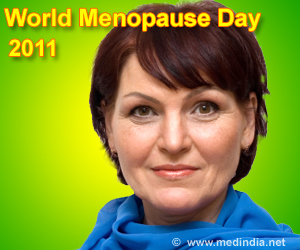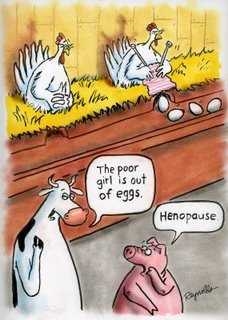World Menopause Day 2024 is on Friday, October 18, 2024: Do any female animals experience menopause?
Friday, October 18, 2024 is World Menopause Day 2024. World Menopause Day World Menopause Day will take
As an Amazon Associate I earn from qualifying purchases.

Humans (female) are a species that experience menopause. Info follows:
Menopause
Menopause is quite simply the final pause of menstruation. This phase of a woman's life is part of the natural aging process. It is not a disease or a disaster. Your ovaries slowly reduce the level of hormones (estrogen and progesterone) they produce and child bearing is no longer an option. For many women this is a big relief. Generally speaking, health professionals agree that 52 is the average age when full menopause takes affect. The full age range is between 42 to 56.
Menopause is preceded by perimenopause and followed by post menopause. All three stages come with their own telltale signs with considerable overlap from one to the other. So, unlike the beginning of your period, which seems to happen in a single moment of time, menopause is very wishy washy. Full menopause is considered to be in effect when you have not had your period for a full year.
Menopause is not experienced by all women in the same way. Much depends on the individual's diet, lifestyle, genetics and attitudes held by the woman, her family, culture and society about aging. If you come from a world that does not respect older people, and is narrowly focused on youth, your menopause transition period may be more difficult to navigate. However, you may also experience deep personal growth and a strong sense of liberation.
Be aware that our commercialized society will try to medicalize your symptoms. Be wise. Look for natural alternatives before getting on the pill band wagon. Weigh the risks and benefits carefully. Become your own authority.
There is a home-use test that you can take to determine if you are perimenopausal or fully menopausal. U.S Food and Drug Administration approved kits measure Follicle Stimulating Hormone (FSH) in your urine. FSH is a hormone produced by your pituitary gland. FSH levels increase temporarily each month to stimulate your ovaries to produce eggs. When you enter menopause and your ovaries stop working your FSH levels also increase. The test will provide a FSH level reading so that you can determine what stage of "the Pause" you are at.
As for rabbits, this study may interest you:
Lack of difference among progestins on the anti-atherogenic effect of ethinyl estradiol: a rabbit study
Peter Alexandersen1,3, Jens Haarbo1, Pieter Zandberg2, Jørgen Jespersen1, Sven O. Skouby1 and Claus Christiansen1
1 Center for Clinical & Basic Research, Ballerup Byvej 222, 2750 Ballerup, Denmark and 2 Department of Vascular Pharmacology, N.V.Organon, Molenstraat 110, 5340 BH Oss, The Netherlands
3 To whom correspondence should be addressed. e-mail: pa@ccbr.dk
Abstract
Top
Abstract
Introduction
Materials and methods
Results
Discussion
References
BACKGROUND: Progestins in combination with estrogen are believed to have different effects on the cardiovascular system. The aim of this study was to investigate the influence of different oral contraceptive formulations on the development of experimental atherosclerosis and vascular reactivity. METHODS: A total of 160 sexually mature rabbits were ovariectomized and randomly assigned to equally large groups: (i) a cholesterol-rich diet (320 mg/day), either given alone (placebo), or together with (ii) ethinyl estradiol (EE 70 µg/day, oral), (iii) desogestrel (DSG 525 µg/day, oral), (iv) gestodene (GSD 262.5 µg/day, oral), (v) levonorgestrel (LNG 525 µg/day, oral), (vi) EE + DSG, (vii) EE + LNG, or (viii) EE + GSD. After 31 weeks of treatment, aortic accumulation of cholesterol and vascular vasoreactivity (in vitro) were determined. RESULTS: Progestins alone did not reduce the accumulation of cholesterol. EE alone or in combination with a progestin reduced the accumulation of cholesterol relative to placebo (P < 0.0001). Isolated vessels from EE-treated animals relaxed significantly more to physiological concentrations of acetylcholine than did placebo (P < 0.001), whereas vessels treated with EE plus a progestin showed an intermediate response. CONCLUSION: The progestins investigated can be combined with EE without attenuating the anti-atherogenic effect of EE.
Key words: atherosclerosis/estrogen/progestins/rabbits/vascular reactivity
Introduction
Top
Abstract
Introduction
Materials and methods
Results
Discussion
References
The question of whether oral contraceptive (OC) formulations increase the risk of arterial events (such as myocardial infarction) in younger women remains unsolved. Several recent case–control studies have reported an increased risk of myocardial infarction in women using OC compared with non-users (Jick et al., 1996; Lewis et al., 1996; 1997; World Health Organization, 1997; Lewis, 1998; Dunn et al., 1999; 2001; Farley et al., 1999; Tanis et al., 2001; Rosendaal et al., 2002), although other recent data have not confirmed this observation (Sidney et al., 1998). Recent European studies have indicated that OC use is associated with increased risk of myocardial infarction, in contrast to US studies that found no increased risk among OC users (Lewis 1998; Sidney et al., 1998). Only a few studies have directly compared the effect on myocardial infarction of OC formulations containing a second-generation progestin (levonorgestrel) with those containing third-generation progestins (desogestrel or gestodene) (Jick et al., 1996; Lewis et al., 1996; 1997; World Health Organization, 1997; Dunn et al., 2001; Tanis et al., 2001), but they were all designed as case–control studies; the reported relative risk in these studies varies (between 0.3 and 1.8), and the numbers are small.
The relative preponderance in venous events (e.g. deep venous thrombosis) as compared with arterial events (e.g. myocardial infarction) in pre-menopausal women is gradually equalized as the menopause is reached, so that the relative frequency of these events is close to 1:1 in peri-menopausal women. Since OC are prescribed for millions of pre-menopausal (and peri-menopausal) women who use these formulations for many years, it would be of the utmost public health importance to establish even a small increase in the relative risk. Therefore, the issue of OC in relation to arterial disease is highly relevant. It should be borne in mind, however, that it is possible that for both OC and HRT users, there may be prothrombotic mechanisms in relation to arterial as well as venous complications that are not necessarily based on atherosclerosis, but that are reflected in the population-based studies. Primary (Rossouw et al., 2002) and secondary (Grady et al., 2002) prevention studies of HRT have failed to show cardioprotection in post-menopausal women.
We report here the results from an experimental study in rabbits of atherosclerosis designed to investigate the effect of estrogen (ethinyl estradiol, EE) in combination with levonorgestrel (LNG), desogestrel (DSG), or gestodene (GSD) on vascular reactivity, lipoprotein metabolism, and the aortic accumulation of cholesterol.
Materials and methods
Top
Abstract
Introduction
Materials and methods
Results
Discussion
References
Study design
A total of 160 sexually mature female rabbits of the Danish Country strain (SSC:CPH) were obtained from Statens Serum Institute, Denmark. They were individually housed at room temperature (20 ± 2°C), a relative humidity of 55 ± 5%, and with a 12 h light cycle. The study was conducted in the animal facilities at the Center for Clinical & Basic Research (CCBR), Ledoeje, Denmark. After a 2 week period of acclimatization, the animals underwent bilateral ovariectomy to inhibit intrinsic production of sex hormones (Alexandersen et al., 1998). One week after surgery, the rabbits were then randomly assigned to one of the following eight treatment groups: (i) a cholesterol-rich diet (320 mg/day), either given alone (placebo), or together with (ii) EE (orally, 70 µg/day), (iii) DSG (orally, 525 µg/day), (iv) GSD (orally, 262.5 µg/day), (v) LNG (orally, 525 µg/day), (vi) EE continuously combined with DSG (doses as above) (EE + DSG), (vii) EE continuously combined with LNG (doses as above) (EE + LNG), or (viii) EE continuously combined with GSD (doses as above) (EE + GSD). We did not include a sham-operated group in this study as it was previously shown that sham operation per se in rabbits results in a mean accumulation of cholesterol that was not statistically significant from that of the non-treated control group (Haarbo et al., 1992). Hormone doses used in this study were chosen based on previous experience with these doses (the McPhail test in rabbits; EE, LNG and DSG) (van der Vies and de Visser, 1983; Sulistiyani et al., 1995; Zandberg et al., 2001) or from in-house studies (GSD). The EE dose used was kept constant in all EE groups throughout the study period (31 weeks). We used the rabbit to evaluate the effect of sex steroids on atherogenesis because it is known to be a useful model of experimental atherosclerosis (Haarbo et al., 1991; 1992; Sulistiyani et al., 1995).
Key effect variables of the study comprised aortic atherosclerosis (i.e. fatty streaks and plaque formation), and vascular reactivity (primary key variables); and body weight, serum lipids and lipoproteins, uterus wet weight, hepatic cholesterol content, uterine estrogen receptor content, liver enzyme concentration, haemoglobin, and white cell count (secondary key variables).
The study was approved and overviewed by the Experimental Animals Committee under the Danish Ministry of Justice. All procedures complied with the Danish guidelines for experimental animal studies.
Rabbit chow
Each rabbit was fed 100 g of chow per day throughout the entire study. The cholesterol-rich chow was prepared by first dissolving the hormone or the combination of hormones (all provided by N.V. Organon, The Netherlands) in ethanol (96%; 0.50 ml per animal per day), then mixing with maize oil (Unikem, Denmark). Another mixture was prepared by dissolving cholesterol (SIGC-8503; Bie & Berntsen A/S, Denmark) in maize oil by slow heating. The hormone solution and the cholesterol solution containing maize oil (total daily intake of maize oil was 8 ml per animal) were then mixed manually together with the pellets (Altromin 2123, Brogaarden, Denmark), as previously described (Alexandersen et al., 1998). Food consumption was monitored weekly by weighing remaining chow. All animals had free access to water.
Blood samples
Blood samples were taken at baseline (week 0) and in weeks 6, 14 and 30. Blood samples were collected from a lateral ear vein on fasting animals (24 h) and analysed at the CCBR laboratory (Ballerup, Denmark) immediately after collection, except for the progestin concentrations that were assessed at Organon.
Safety variables
Haemoglobin, haematocrit, red blood cell count, leukocyte count (Sysmex K-1000; Toa Medical Electronics, Inc., USA) and alanine aminotransferase (ALAT) (Cobas Mira Plus; Roche Diagnostic Systems, Inc., F.Hoffmann–La Roche, Switzerland) were determined in weeks 0, 6, 14 and 30.
Serum lipids and lipoproteins
Total serum cholesterol (TC) and triglycerides (TG) were measured enzymatically by kinetic colorimetric methods (Cobas Mira). Ultracentrifuged lipoproteins were determined regularly throughout the study as described in detail elsewhere (Haarbo et al., 1991; 1992; Alexandersen et al., 1998).
Serum progestin concentrations
A kinetic study was performed after 16 weeks of treatment to determine the serum concentrations of the respective progestins. Blood samples were taken before dosing, and then again 1, 2, 3, 4, 6, 8 and 24 h after dosing, but taking only two samples per animal in each group (providing 40 samples per group), to give an impression of the pharmacokinetic profile of these compounds. These hormone concentrations were determined at Organon’s laboratories.
Desogestrel
DSG study samples were determined according to a validated assay. The limit of quantification for this study was 1.0–200 ng DSG per ml plasma DSG and its internal standard (IS), an analogue of DSG, were isolated from 0.1 ml of rabbit plasma by solid-phase extraction (SPE) with C-18 cartridges. The plasma extracts were analysed using an API 365 LC-MS-MS system. The liquid chromatograph was equipped with an analytical Luna Phenyl Hexyl column. Ion spray was applied as ionization technique, monitoring m/z 325.4 (M + H) with fragment ion m/z 147.2 for DSG and m/z 339.20 (M + H) with fragment ion m/z 229.1 for its IS.
Gestodene
GSD study samples were determined according to a validated assay. The limit of quantification for this study was 1.0–200 ng of GSD per ml plasma. GSD and its IS, an analogue of GSD, were isolated from 0.1 ml of rabbit plasma by SPE with C-18 cartridges. The plasma extracts were analysed using an API 365 LC-MS-MS system. The liquid chromatograph was equipped with an analytical Hypersil BDS C18 column. Atmospheric pressure chemical ionization was applied as ionization technique, monitoring m/z 311.0 (M + H) with fragment ion m/z 109.1 for GSD and m/z 339.10 (M + H) with fragment ion m/z 229.20 for its IS.
Levonorgestrel
LNG study samples were determined according to a validated assay. The limit of quantification for this study was 1.0–200 ng of LNG per ml plasma. LNG and its IS, an analogue of LNG, were isolated from 0.1 ml of rabbit plasma by SPE with C-18 cartridges. The plasma extracts were analysed using an API 365 LC-MS-MS system. The liquid chromatograph was equipped with an analytical Luna Phenyl Hexyl column. Ion spray was applied as ionization technique, monitoring m/z 313.3 (M + H) with fragment ion m/z 109.2 for LNG and m/z 339.20 (M + H) with fragment ion m/z 229.10 for its IS.
Aortic accumulation of cholesterol
Necropsy (week 32) was done with an i.v. injection of 1–2 ml of mebumal (pentobarbital) 20% solution. The thoracic aorta (just above the aortic valves to the level of the diaphragm) was dissected free, and the connective tissue adhering to the adventitia was then carefully removed under running saline. The aorta was cut longitudinally and the luminal surface was rinsed with saline. The vessel was fixed at the corners with pins onto a piece of paper on a corkboard. The tissue was separated in two parts (a proximal and a distal part) at the level of the first intercostal arteries. The proximal part was utilized to strip the luminal layer containing the intima and part of the media from the underlying media/adventitia. The proximal part was weighed and stored at –20°C until analysed. For analysis, the luminal layer of the aortic tissue was minced and the lipids were extracted chemically with chloroform and methanol (2:1, vol/vol) over 24 h. The lipids were separated from the proteins (Haarbo et al., 1991). The total aortic cholesterol content in the tissue specimens was measured enzymatically after the fraction containing cholesterol had been taken to dryness by heating and then dissolved in 1.0 ml of 2-propanol. The amount of protein in the aorta was measured as described by Lowry (1951). The weight of the heart was recorded.
Morphometric analysis of aortic plaque area
The aorta (comprising the ascendant part, the arch, and the descendant part, from the aortic valves and to the first intercostal artery) was opened longitudinally and rinsed in 50% ethanol and dyed in Sudan Red for 1 min. Each aortic tissue dyed was projected onto a horizontal surface with a projecting videocamera (JAI 2040 Protec, Japan) and videotaped under microscope (Zeiss Stemi 2000/C, Germany). The images obtained were then digitized (ImagePro Plus, USA) to determine the surface involvement of atherosclerotic lesions (fatty streaks) and the total area occupied by the atheroma plaque (see below). Surface involvement by atherosclerosis in an animal was assessed by tracing the contours of the lumen expressed as percentage of the total aortic area. Summing the degree of surface involvement per animal and dividing by the number of animals in the group, the mean degree of surface involvement by atherosclerosis in a treatment group was calculated. Sudan Red was found not to significantly interfere with chemical determination of aortic accumulation of cholesterol (data not shown).
Preparation of aortic rings and tension monitoring
Isolated vascular segments (3–4 mm transverse sections) from the thoracic aorta were prepared from the newly killed rabbit (Furchgott and Zawadzki 1980). Five to ten rabbits randomly selected from each group were used. The rings were immediately placed in ice-cold Krebs’ solution and cleaned under careful protection of the endothelium. The Krebs’ solution consisted of (mmol/l): NaCl 118.0, KCl 4.7, CaCl2 2.6, MgSO4 1.2, KH2PO4 1.2, NaCHO3 24.9, and glucose 11.1. The isolated rings were mounted in the organ bath on two parallel and horizontal stainless steel wires (40 µm in diameter) inserted into the lumen of the vessel. The bath contained Krebs’ solution at 37°C, carbonized with 95%/5% of O2/CO2. One hook was fixed, and the other connected to a force transducer measuring the isometric tension of the ring (Myograph 400; JP Trading A/S, Denmark). Initially, the rings were stretched to a basal tension of 2.0 g and allowed to equilibrate for 45 min. From other experiments, it was found that a basal tension of 2.0 g developed the maximal active tension in the rings (data not shown), and the basal tension was therefore increased to 2.0 g before each experiment and allowed to equilibrate for ≥30 min. The rings were then contracted twice with a 126 mmol/l K+ Krebs’ solution, which is identical to Krebs solution, except that Na+ in the Krebs’ was exchanged with K+ on a molar basis. The experiment began with repeated contraction with phenylephrine to 40% of their maximal contraction with high dose potassium (126 mmol/l). Cumulative dose–response curves to acetylcholine were then obtained in the concentration range of 10–8 to 10–5 mol/l. The rings were washed and allowed to relax. The vessels were then stimulated with phenyleprine again to 50% of the maximal contractile response to 126 mmol/l of K+ , and dose–response curves were subsequently obtained for sodium nitroprusside (4x10–8 to 1.3x10–5 mol/l).
Liver accumulation of cholesterol
The amount of cholesterol accumulated during the study was determined after homogenization of a liver biopsy taken at the time of necropsy. Hepatic cholesterol concentrations were assessed after homogenization and adjusted for hepatic protein similarly as described for aortic cholesterol determinations (Haarbo et al., 1991).
The uterus and endometrial tissue
The bicornuate uterus was cut at the level of the vagina and beginning of the salpinges, removed and the wet weight determined. A sample of endometrial tissue was excised and immediately frozen in liquid nitrogen, and stored at –85°C until analysis. For analysis, the endometrial tissue was homogenized and centrifuged at 800 g. The supernatant was then further centrifuged at 105 000 g, and the obtained supernatant (cytosol) was used for determination of cytosolic estrogen-binding capacity by steroid-binding assay with dextran-coated charcoal separation (Thorpe, 1987). The estrogen-binding capacity was adjusted for the protein concentration in the cytosol (Bradford, 1976). The 800 g pellet was washed, the nuclear receptors extracted by 0.6 mol/l KCl (Thorpe et al., 1986) and the nuclear estrogen receptor content determined by an enzyme immunoassay (Abott Laboratories). The inter-assay variation of the estrogen-binding capacity and the estrogen receptor (immunoassay) and protein determination were 7, 6 and 5% respectively. All analyses were done without knowledge of the treatment group.
Statistics
The mean levels of serum lipids and lipoproteins during the treatment period were calculated as the area under the curve (AUC). Analysis of variance (ANOVA) was performed for the primary and secondary key variables. If ANOVA indicated statistical significance, Student’s t-test was used to compare groups against the placebo group using Dunnett’s correction for multiple comparisons. The relationship between aortic accumulation of cholesterol and the averaged serum total cholesterol (and lipoprotein) level was determined by correlation analysis. Dose–response curves for acetylcholine were performed for each treatment group (n = 5–10), and ANOVA was used to test for statistical differences among groups at each concentration of acetylcholine. Linear correlation was performed between accumulation of cholesterol and vascular response to acetylcholine. Analysis of co-variance (ANCOVA) was used to investigate the significance of serum lipids and lipoproteins and of other non-lipid-mediated effects of the hormone treatments (independent variables) on the accumulation of cholesterol (dependent variable), and to study the degree of endothelial dysfunction (dependent variable) after correction for aortic accumulation of cholesterol and treatment (independent variables). All statistical analyses were performed with 5% as the level of significance.
Results
Top
Abstract
Introduction
Materials and methods
Results
Discussion
References
Table I gives the baseline characteristics for the eight study groups in terms of body weight and serum lipids and serum high-density lipoprotein cholesterol (HDL-C). There was no statistically significant difference among groups for any variable tested. During the study, all groups significantly increased the body weight by 20% (P < 0.05). Treatment with DSG, GSD, or LNG did not significantly affect the average TC concentration (Table II). However, treatment with EE or EE plus a progestin significantly lowered average TC concentrations. Changes in TC were paralleled by modifications in the atherogenic lipoproteins (LDL-C, IDL-C, and VLDL-C) (ANOVA: P < 0.001 for all), and all hormone treatments (progestins alone or in combination with EE) significantly increased average HDL-C concentrations (ANOVA: P < 0.001).
View this table:
[in this window]
[in a new window]
Table I. Baseline characteristics
View this table:
[in this window]
[in a new window]
Table II. Mean (SEM) serum lipid and lipoprotein concentrations calculated from the area under the concentration–time curve (AUC)
Cholesterol feeding per se resulted in an extensive aortic accumulation of cholesterol (nmol/mg wet weight) and this was significantly attenuated by long-term treatment with EE (P < 0.0001) or EE plus a progestin (P < 0.0001) (Figure 1). However, treatment with a progestin alone (DSG, GSD, LNG) had no effect on the aortic accumulation of cholesterol relative to placebo. Aortic accumulation of cholesterol in animals that died prematurely in the EE group was not quantified. ANOVA indicated that treatment with EE and EE + DSG (but not the other treatments) had a significant inhibitory effect on the accumulation of cholesterol, independent on serum lipids and lipoproteins {estimate [mean (SEM)] for EE, –22.1 (9.7) mmol/l/mg wet weight P = 0.024; for EE + DSG, –19.7 (8.4) mmol/l/mg wet weight P = 0.021; and for EE + GSD, –16.5 (9.0) mmol/l/mg wet weight P = 0.068. For other treatments, ANCOVA yielded P > 0.5}.
View larger version (20K):
[in this window]
[in a new window]
Figure 1. Individual values for the aortic accumulation of cholesterol (µmol/mg wet weight) (upper part of the figure) or the morphometric data based on the area of the aortic arch covered by plaque (lower part of the figure) in the eight groups. EE = ethinyl estradiol; DGS = desogestrel; GTD = gestodene; LNG = levonorgestrel. Rabbits treated with EE alone or in combination with a progestin (DSG, GSD or LNG) had significantly lower accumulation of cholesterol and atherosclerotic plaque than placebo. There was no statistically significant difference between the progestin groups and the placebo group. ***P < 0.0001 (analysis of variance).
Morphometric analysis of the plaque covering the surface of the thoracic aorta revealed that there were significantly more atheromatous lesions in the placebo group than in the EE and the EE + progestin groups (P < 0.001 for all groups versus placebo) (Figure 1 and Figure 2). This still held true after adjustment for multiple comparisons (P < 0.0001).
View larger version (62K):
[in this window]
[in a new window]
Figure 2. Representative samples of the aortic arches used for morhometric determination of the area covered by atherosclerotic plaques. Upper panel shows examples from the placebo group (cholesterol feeding alone; placebo), and the ethinyl estradiol (EE) group; whereas the lower panel shows examples from each of the EE + progestin groups. There was significantly less plaque accumulated in the EE group and the EE + progestin groups compared with placebo (P < 0.0001). Numbers indicate animal identifications.
Figure 3 shows the EC50 to acetylcholine for the various treatment groups (top). There was no significant difference between groups, but treatment with EE and EE plus a progestin tended to have lower EC50 values than controls. The response to two physiological doses of acetylcholine (1.0x10–7 and 3.2x10–7 mol/l) in precontracted vessels is shown (centre and bottom). Vessels treated with EE relaxed significantly more to acetylcholine than control vessels or vessels with a progestin alone (P < 0.05). Moreover, combining EE with a progestin relaxed the vessels significantly more than control vessels but to a lesser extent than with EE alone. Vasorelaxation to physiological concentrations of acetylcholine (1.0x10–7 and 3.2x10–7 mol/l) correlated significantly and inversely to aortic accumulation of cholesterol (r = –0.39 P = 0.002 and r = –0.37 P = 0.004 respectively). To study the influence of increasing accumulation of cholesterol on the endothelial dysfunction evaluated by vascular reactivity in vitro, ANCOVA was done. We found that treatment with EE significantly and independently of aortic accumulation of cholesterol restored vasorelaxation {for EE: estimate [mean (SEM)] was 49.3 (10.4)%, P = 0.0001}, whereas the other treatments with EE plus a progestin or a progestin alone [DSG, –7.7 (9.2)% (not significant); GSD, –8.5 (9.1)% (not significant); LNG, –3.2 (9.7)% (not significant); EE + DSG, 17.7 (9.4)% (P = 0.065); EE + GSD, 13.2 (10.2)% (not significant); and EE ± LNG, 17.0 (8.8)% (P = 0.058)], or accumulation of cholesterol per se [–0.1 (0.2)%] did not.
View larger version (19K):
[in this window]
[in a new window]
Figure 3. The EC50 values for acetylcholine of isolated vessels for the treatment groups (top). There was no significant difference between groups, but treatment with ethinyl estradiol (EE) alone or combined with a progestin tended to have lower EC50 values than the placebo group. Long-term treatment with EE alone or combined with a progestin relaxed precontracted vessels to two physiological doses of acetylcholine [1.0x10–7 mol/l (centre) and 3.2x10–7 mol/l (bottom) significantly more than control vessels (black bar; P < 0.0001)]. Abbreviations as in Figure 1.
The uterine wet weight was significantly higher in EE-treated animals than in controls (P < 0.0001; Figure 4). Progestins had a neutral effect on uterine wet weight, while EE in combination with any of the progestins significantly increased the wet weight indicating that the progestins with the doses used were not able to completely abolish the stimulatory effect of EE on this target organ (Figure 4). The uterine cytosolic estrogen receptor (ER) concentrations were significantly lowered in the EE group (P < 0.0001) and also in each of the EE plus progestin groups (P < 0.001–0.0001) relative to the placebo group, but also the progestins alone resulted in reduced concentrations compared with controls (P < 0.001) (Table III). For the nuclear ER concentrations there was no significant differences for any of the treatment groups, but all were lower than the control group.
View larger version (12K):
[in this window]
[in a new window]
Figure 4. Uterine wet weight for the rabbits according to treatment. The wet weight was significantly higher in ethinyl estradiol (EE)-treated animals than in the control group (P < 0.0001). Progestins themselves had a neutral effect on uterine wet weight, while EE in combination with a progestin all significantly increased the wet weight (P < 0.0001). Abbreviations as in Figure 1.
View this table:
[in this window]
[in a new window]
Table III. Hepatic cholesterol content and uterine cytosolic and uterine nuclear estrogen receptor content (fmol/mg protein)
Safety aspects in relation to the study
Figure 5 shows that the rabbits receiving EE or EE plus a progestin had concentration peaks for the progestin between 1 and 8 h after administration, as based on the kinetic study. The differences in the area under the curve for LNG versus DSG, and EE + LNG versus EE + DSG respectively, indicate a difference in the serum concentrations of these two progestins and may, in part, reflect difference in protein binding. Nevertheless, the serum concentrations of LNG in rabbits are similar to those reported for women (Kook et al., 2002).
View larger version (22K):
[in this window]
[in a new window]
Figure 5. Mean concentrations in serum (ng/ml) of the various progestins alone or when combined with ethinyl estradiol. Abbreviations as in Figure 1.
During the last 6–8 weeks, the animals and particularly those in the EE group ceased increasing in body weight probably as a result of general health deterioration, and in the EE group a significant number of rabbits (n = 8) did not complete the study. Autopsy of these animals suggested a toxic estrogenic effect of the liver (liver cirrhosis) and of the uterus (probably deciduocarcinoma) by macroscopic examination, as previously reported as a consequence of exogenous estrogens (Janne et al., 2001). Due to decay of the internal organs the precise cause of death could not be determined in most cases. Table IV summarizes the percentage change in ALAT, haemoglobin, and white cell count. In the EE group, eight rabbits died prematurely (mostly after week 20). The temporary increase in ALAT (week 6) in the LNG, EE + DSG, EE + GSD, and EE + LNG groups decreased after 6 weeks of treatment, but never fully returned to pretreatment values (Table IV). The general health of the animals in the EE group as determined by the haemoglobin, red blood cell count and haematocrit (not shown), and clinical appearance deteriorated in the last period of the study, probably as a result of a toxic effect of the EE dose used.
View this table:
[in this window]
[in a new window]
Table IV. Mean (SEM) percentage changes from baseline in liver enzyme concentration, haemoglobin, and white cell count
Discussion
Top
Abstract
Introduction
Materials and methods
Results
Discussion
References
The principal results of this experimental study was that EE either alone or in continuous combination with one of the progestins used, i.e. LNG, DSG or GSD, significantly inhibited the aortic accumulation of cholesterol relative to placebo (cholesterol-feeding alone), whereas treatment with progestin monotherapy had a neutral effect on atherogenesis, irrespective of the progestin used. After adjustment for lipids and lipoproteins, there still was an apparently inhibitory effect of EE on aortic accumulation of cholesterol suggesting a lipid concentration-independent mechanism of action for EE on atherogenesis. A previous study in non-human monkeys also found that animals treated with EE in combination with LNG (as a triphasic OC formulation) had significantly less iliac artery atherosclerosis than control animals (Kaplan et al., 1995). Extrapolating experimental data to the human situation should be done with caution, but only two population-based studies have been specifically designed to investigate the role of second versus third generation OC formulations on the risk of myocardial infarction (Dunn et al., 1999; Tanis et al., 2001). In the study by Dunn et al., the relative risk was found to be increased with third generation compared with second generation OC formulations [OR, 1.8 (95% CI, 0.7–4.8)], whereas in the study by Tanis et al. the relative risk was found to be decreased with third generation compared with second generation formulations [OR, 0.5 (95% CI, 0.2–1.1]. In addition, presence of cardiovascular risk factors (smoking and arterial hypertension) seems to be crucial for development of myocardial infarction in women taking OC (World Health Organization, 1997; Farley et al., 1998; Lewis, 1998; Petitti et al., 2000; Tanis et al., 2001). In fact, the WHO study found no increased risk of myocardial infarction in non-smoking women with no other cardiovascular risk factors who also reported blood pressure check before starting use of combined OC. Controlled, randomized studies are therefore clearly needed, although these studies will be of a considerable size taking into account the expected low incidence of myocardial infarction in pre-menopausal women (Crook and Godsland, 1998), and consequently such trials are very expensive to perform. Therefore, until clinical data on vascular endpoints are available, experimental animal studies may provide important clues in terms of the effect of various OC formulations on atherogenesis.
Data on the direct effect of OC formulations on the human arterial system are lacking (Kuhl, 1996). We found evidence that the OC formulations used in this study had a direct effect on the arteries of cholesterol-fed rabbits. Acetylcholine-mediated relaxation of precontracted aortic rings was increased in the EE plus progestin groups, although less than in the EE group alone as compared with placebo. EE’s significant effect on restoring vasorelaxation was found to be independent of the accumulation of cholesterol in the aortic wall. However, we also found that the addition of the progestins influenced the estrogen-induced vasorelaxation (Figure 3), although by an unknown mechanism of action. Recently, in a study of precontracted rabbit jugular veins, EE, LNG, DSG and GSD were reported to induce relaxations in vessels with intact endothelium (Herkert et al., 2000). However, this area warrants further investigation.
It is well known that cholesterol-fed rabbits show alterations in their lipoprotein metabolism that differ from the human situation (Haarbo et al., 1991; 1992). Combination of EE with a progestin in this study reflected the estrogenic effect. Furthermore, the three combined treatments lowered serum lipids and the atherogenic lipoprotein levels significantly and similarly to EE monotherapy. In contrast, treatment with a progestin alone did not affect these variables differently from the controls, in accordance with earlier findings (Haarbo et al., 1992). In women, OC frequently increases serum triglycerides (Gevers Leuven et al., 1990; Kuhl et al., 1990; Leuven et al., 1990; Lobo et al., 1996; Cheung et al., 1999).
The dose of EE was selected to reflect serum concentrations of EE in peri-menopausal women taking OC. However, the duration of the present study was longer than in many previous studies (20 weeks). Among the animals receiving EE alone, 40% died after only ≥21 weeks of treatment, whereas animals given combined treatment did not die prematurely. This suggests that the accumulated estrogen dose may have been too high and/or the study too long, as also indicated by the safety variables of the EE-treated animals at week 30 (Table IV), but also that adding a progestin was able to negate this toxic effect. Progestins were used in equipotent doses (i.e. in combination with EE they inhibit endometrial stimulation equally in humans) relative to each other. The selected dose of the progestins (µg per kg body weight) was chosen based on previous experience (van der Vies and de Visser, 1983; Sulistiyani et al., 1995; Zandberg et al., 2001) and in-house studies (in Organon), but may be considered as high doses. All three OC formulations significantly decreased the concentration of the cytosolic ER concentration relative to controls, suggesting that these formulations affect the endometrium through a down-regulation of the cytosolic ER. Addition of a progestin in this study also down-regulated the ER although less than found for EE, and when combining EE with a progestin, the estrogen component dominated the ER regulation. It should, however, be emphasized that the lack of modifying effect of the progestins relative to the EE dose on the endometrium should not be taken as a lack of progestogenic effect, since the primary intention was to investigate the effect of these hormone combinations on atherosclerosis and arterial responsiveness.
A type II statistical error is not likely to have occurred in our study. However, the accumulation of cholesterol (and amount of fatty streaks) in the EE group was significantly lower than that of the placebo animals. For a type II error to occur, the null hypothesis (that there was no difference in aortic accumulation of cholesterol between the EE and the placebo group) would not be true, and despite this, we would obtain a non-significant result, i.e. a ‘false negative’ result.
In conclusion, the present study demonstrates that in ovariectomized cholesterol-fed rabbits, the progestins investigated (LNG, DSG, or GSD) can be combined with EE without attenuating the anti-atherogenic effect of EE, partly by decreasing atherogenic lipoproteins, and partly by a direct effect on the endothelium, modulating the aortic vasomotor response in vitro.
References
Top
Abstract
Introduction
Materials and methods
Results
Discussion
References
Alexandersen, P., Haarbo, J., Sandholdt, I., Shalmi, M., Lawaetz, H. and Christiansen, C. (1998) Norethindrone acetate enhances the antiatherogenic effect of 17beta-estradiol: a secondary prevention study of aortic atherosclerosis in ovariectomized cholesterol-fed rabbits. Arterioscler. Thromb. Vasc. Biol., 18, 902–907.[Abstract/Free Full Text]
Bradford, M.M. (1976) A rapid and sensitive method for the quantitation of microgram quantities of protein utilizing the principle of protein-dye binding. Anal. Biochem., 72, 248–254.[CrossRef][ISI][Medline]
Cheung, M.C., Walden, C.E. and Knopp, R.H. (1999) Comparison of the effects of triphasic oral contraceptives with desogestrel or levonorgestrel on apolipoprotein A-I-containing high density lipoprotein particles. Metabolism, 48, 648–664.
Crook, D. and Godsland, I. (1998) Safety evaluation of modern oral contraceptives. Effects on lipoprotein and carbohydrate metabolism. Contraception, 57, 189–201.[CrossRef][ISI][Medline]
Dunn, N.R., Faragher, B., Thorogood, M., de Caestecker, L., MacDonald, T.M., McCollum, C., Thomas, S. and Mann, R. (1999) Risk of myocardial infarction in young female smokers. Heart, 82, 581–583.[Abstract/Free Full Text]
Dunn, N.R., Arscott, A. and Thorogood, M. (2001) The relationship between use of oral contraceptives and myocardial infarction in young women with fatal outcome, compared to those who survive: results from the MICA case–control study. Contraception, 63, 65–69.[CrossRef][ISI][Medline]
Farley, T.M., Meirik, O., Chang, C.L. and Poulter, N.R. (1998) Combined oral contraceptives, smoking, and cardiovascular risk. J. Epidemiol. Community Health, 52, 775–785.[Abstract]
Farley, T.M., Meirik, O. and Collins, J. (1999) Cardiovascular disease and combined oral contraceptives: reviewing the evidence and balancing the risks. Hum. Reprod. Update, 5, 721–735.[Abstract/Free Full Text]
Furchgott, R.F. and Zawadzki, J.V. (1980) The obligatory role of endothelial cells in the relaxation of arterial smooth muscle by acetylcholine. Nature, 288, 373–376.[CrossRef][ISI][Medline]
GeversLeuven, J.A., Dersjant-Roorda, M.C., Helmerhorst, F.M., de Boer, R., Neymeyer-Leloux, A. and Havekes, L. (1990) Estrogenic effect of gestodene- or desogestrel-containing oral contraceptives on lipoprotein metabolism. Am. J. Obstet. Gynecol., 163 (1 Pt 2), 358–362.[ISI][Medline]
Grady, D., Herrington, D., Bittner, V., Blumenthal, R., Davidson, M., Hlatky, M., Hsia, J., Hulley, S., Herd, A., Khan, S. et al. (2002) Cardiovascular disease outcomes during 6.8 years of hormone therapy: Heart and Estrogen/progestin Replacement Study follow-up (HERS II). J. Am. Med. Assoc., 288, 49–57.[Abstract/Free Full Text]
Haarbo, J., Leth-Espensen, P., Stender, S. and Christiansen, C. (1991) Estrogen monotherapy and combined estrogen-progestogen replacement therapy attenuate aortic accumulation of cholesterol in ovariectomized cholesterol-fed rabbits. J. Clin. Invest., 87, 1274–1279.[ISI][Medline]
Haarbo, J., Svendsen, O.L. and Christiansen, C. (1992) Progestogens do not affect aortic accumulation of cholesterol in ovariectomized cholesterol-fed rabbits. Circ. Res., 70, 1198–1202.[Abstract]
Herkert, O., Kuhl, H., Busse, R. and Schini-Kerth, V.B. (2000) The progestin levonorgestrel induces endothelium-independent relaxation of rabbit jugular vein via inhibition of calcium entry and protein kinase C: role of cyclic AMP. Br. J. Pharmacol., 130, 1911–1918.[CrossRef][ISI][Medline]
Janne, O.A., Zook, B.C., Didolkar, A.K., Sundaram, K. and Nash, H.A. (2001) The roles of estrogen and progestin in producing deciduosarcoma and other lesions in the rabbit. Toxicol. Pathol., 29, 417–421.[CrossRef][ISI][Medline]
Jick, H., Jick, S., Myers, M.W. and Vasilakis, C. (1996) Risk of acute myocardial infarction and low-dose combined oral contraceptives (research letter). Lancet, 347, 627–628.[ISI][Medline]
Kaplan, J.R., Adams, M.R., Anthony, M.S., Morgan, T.M., Manuck, S.B. and Clarkson, T.B. (1995) Dominant social status and contraceptive hormone treatment inhibit atherogenesis in premenopausal monkeys. Arterioslcer. Thromb. Vasc. Biol., 15, 2094–2100.[Abstract/Free Full Text]
Kook, K., Gabelnick, H. and Duncan, G. (2002) Pharmacokinetics of levonorgestrel 0.75 mg tablets. Contraception, 66, 73–76.[CrossRef][ISI][Medline]
Kuhl, H. (1996) Comparative pharmacology of newer progestogens. Drugs, 51, 188–215.[ISI][Medline]
Kuhl, H., Marz, W., Jung-Hoffmann, C., Heidt, F. and Gross, W. (1990) Time-dependent alterations in lipid metabolism during treatment with low-dose oral contraceptives. Am. J. Obstet. Gynecol., 163 (1 Pt 2), 363–369.[ISI][Medline]
Leuven, J.A., Dersjant-Roorda, M.C., Helmerhorst, F.M., de Boer, R., Neymeyer-Leloux, A. and Havekes, L.M. (1990) Effects of oral contraceptives on lipid metabolism. Am. J. Obstet. Gynecol., 163 (4 Pt 2), 1410–1413.[ISI][Medline]
Lewis, M.A. (1998) Myocardial infarction and stroke in young women: what is the impact of oral contraceptives? Am. J. Obstet. Gynecol., 179, S68–S77.[CrossRef][ISI][Medline]
Lewis, M.A., Spitzer, W.O., Heinemann, L.A., MacRae, K.D., Bruppacher, R. and Thorogood, M. (1996) Third generation oral contraceptives and risk of myocardial infarction: an international case–control study. Transnational Research Group on Oral Contraceptives and the Health of Young Women. Br. Med. J., 312, 88–90.[Abstract/Free Full Text]
Lewis, M.A., Heinemann, L.A., Spitzer, W.O., MacRae, K.D. and Bruppacher, R. (1997) The use of oral contraceptives and the occurrence of acute myocardial infarction in young women: results from the Transnational study on oral contraceptives and the health of young women. Contraception, 56, 129–40.[CrossRef][ISI][Medline]
Lobo, R.A., Skinner, J.B., Lippman, J.S. and Cirillo, S.J. (1996) Plasma lipids and desogestrel and ethinyl estradiol: a meta-analysis. Fertil. Steril., 65, 1100–1109.[ISI][Medline]
Lowry, O.H., Rosebrough, N.J., Farr, A.L. and Randall, R.J. (1951) Protein measurement with folin phenol reagent. J. Biol. Chem., 193, 265–275.[Free Full Text]
Petitti, D.B., Sidney, S. and Quesenberry, C.P. Jr (2000) Hormone replacement therapy and the risk of myocardial infarction in women with coronary risk factors. Epidemiology, 11, 603–606.[CrossRef][ISI][Medline]
Poulter, N.P., Chang, C.L., Farley, T.M.M., Kelaghan, J., Meirlk, O. and Marmot, M.G. (1997) Acute myocardial infarction and combined oral contraceptives: results of an international multicentre case–control study. WHO Collaborative Study of Cardiovascular Disease and Steroid Hormone Contraception. Lancet, 349, 1202–1209.[CrossRef][ISI][Medline]
Rosendaal, F.R., Helmerhorst, F.M. and Vandenbroucke, J.P. (2002) Female hormones and thrombosis. Arterioscler. Thromb. Vasc. Biol., 22, 201–210.[Abstract/Free Full Text]
Rossouw, J.E., Anderson, G.L., Prentice, R.L., LaCroix, A.Z., Kooperberg, C., Stefanick, M.L., Jackson, R.D., Beresford, S.A., Howard, B.V., Johnson, K.C. et al. (2002) Risks and benefits of estrogen plus progestin in healthy postmenopausal women: principal results from the Women’s Health Initiative randomized controlled trial. J. Am. Med. Assoc., 288, 321–333.[Abstract/Free Full Text]
Sidney, S., Siscovick, D.S., Petitti, D.B., Schwartz, S.M., Quesenberry, C.P., Psaty, B.M., Raghunathan, T.E., Kelaghan, J. and Koepsell, T.D. (1998) Myocardial infarction and use of low-dose oral contraceptives: a pooled analysis of 2 US studies. Circulation, 98, 1058–1063.[Abstract/Free Full Text]
Sulistiyani, Adelman, S.J., Chandrasekaran, A., Jayo, J. and St Clair, R.W. (1995) Effect of 17 alpha-dihydroequilin sulfate, a conjugated equine estrogen, and ethinylestradiol on atherosclerosis in cholesterol-fed rabbits. Arterioscler. Thromb. Vasc. Biol., 15, 837–846.[Abstract/Free Full Text]
Tanis, B.C., van den Bosch, M.A., Kemmeren, J.M., Cats, V.M., Helmerhorst, F.M., Algra, A., van der Graaf, Y. and Rosendaal, F.R. (2001) Oral contraceptives and the risk of myocardial infarction. N. Engl. J. Med., 345, 1787–1793.[Abstract/Free Full Text]
Thorpe, S.M. (1987) Steroid receptors in breast cancer: sources of inter-laboratory variation in dextran-choarcoal assays. Breast Cancer Res. Treat., 9, 175–189.[CrossRef][ISI][Medline]
Thorpe, S.M., Lykkesfeldt, A.E., Vinterby, A. and Lonsdorfer, M. (1986) Quantitative immunological detection of estrogen receptors in nuclear pellets from human breast cancer biopsies. Cancer Res., 46, 4251S–4255S.[Medline]
vanderVies, J. and de Visser, J. (1983) Endocrinological studies with desogestrel. Arzneimittelforschung, 33, 231–236.[Medline]
World Health Organization (1997) Details?
Zandberg, P., Peters, J.L.M., Demacker, P.N., de Reeder, E.G., Smit, M.J. and Meuleman, D.G. (2001) Comparison of the antiatherosclerotic effect of tibolone with that of estradiol and ethinyl estradiol in cholesterol-fed, ovariectomized rabbits. Menopause, 8, 96–105.[CrossRef][ISI][Medline]
Submitted on December 13, 2002; resubmitted on February 20, 2003; accepted on March 25, 2003.
This article has been cited by other articles:
T. Hayashi, T. Esaki, D. Sumi, T. Mukherjee, A. Iguchi, and G. Chaudhuri
Modulating role of estradiol on arginase II expression in hyperlipidemic rabbits as an atheroprotective mechanism
PNAS, July 5, 2006; 103(27): 10485 - 10490.
[Abstract] [Full Text] [PDF]
--------------------------------------------------------------------------------
This Article
Abstract
FREE Full Text (PDF )
Alert me when this article is cited
Alert me if a correction is posted
Services
Email this article to a friend
Similar articles in this journal
Similar articles in ISI Web of Science
Similar articles in PubMed
Alert me to new issues of the journal
Add to My Personal Archive
Download to citation manager
Search for citing articles in:
ISI Web of Science (2)
Request Permissions
Google Scholar
Articles by Alexandersen, P.
Articles by Christiansen, C.
PubMed
PubMed Citation
Articles by Alexandersen, P.
Articles by Christiansen, C.
Online ISSN 1460-2350 - Print ISSN 0268-1161 [2007 European Society of Human Reproduction and Embryology]

Can chemotherapy cause early menopause?
Calm down, breathe and relax! It's not the end of the world if it is menopause! My mom had breast cancer and, because of the treatments and drugs, developed menopause very early as well, in her early forties. It was hell for her because she couldn't take any of the medicines that ease the symptoms because she was still in remission. You should visit your doctor and talk with him/her about what you're experiencing. Don't be afraid to go. You're not even sure that it is menopause, and if it is, it'll be ok. Try to keep everything in perspective. I know it's a big physical and psychological change to face if it is menopause, but you beat Hodgkins! You will be alright. Good luck!

Feeling sleepy, sluggish. Can this be menopause?
welcome to the wonderful world of pre menopause. Go get your pap test and your Dr. will take a simple blood test to make sure. Then discuss with you things you can do , or problems as they arise. just know, you are not alone. Of course, there are other things it could be, so best bet is to start with your Doc. I am post menopause now. Heres the good news, you get your brain back, no period bloat any more, AND you won't have to shave your legs or armpits more than once a week ! I LOVE IT! ( so does my husband, I use his razor)













